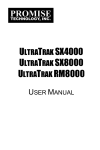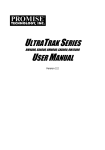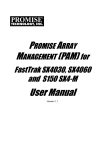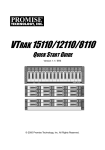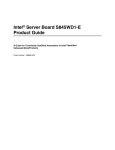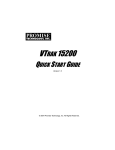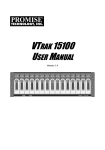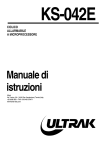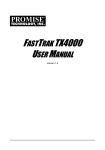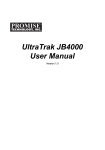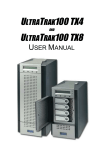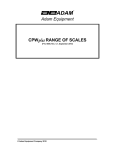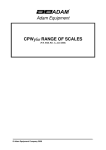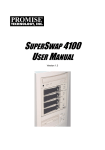Download 1_UltraTrak RM4000 User v1.6
Transcript
ULTRATRAK RM4000 USER MANUAL Version 1.6 UltraTrak RM4000 User Manual Copyright © 2002, Promise Technology, Inc. Copyright by Promise Technology, Inc. (Promise Technology). No part of this manual may be reproduced or transmitted in any form without the expressed, written permission of Promise Technology. Trademarks Promise, and the Promise logo are registered in U.S. Patent and Trademark Office. All other product names mentioned herein may be trademarks or registered trademarks of their respective companies. Important data protection information You should back up all data before installing any drive controller or storage peripheral. Promise Technology is not responsible for any loss of data resulting from the use, disuse or misuse of this or any other Promise Technology product. Notice Although Promise Technology has attempted to ensure the accuracy of the content of this manual, it is possible that this document may contain technical inaccuracies, typographical, or other errors. Promise Technology assumes no liability for any error in this publication, and for damages, whether direct, indirect, incidental, consequential or otherwise, that may result from such error, including, but not limited to loss of data or profits. Promise Technology provides this publication “as is” without warranty of any kind, either express or implied, including, but not limited to implied warranties of merchantability or fitness for a particular purpose. The published information in the manual is subject to change without notice. Promise Technology reserves the right to make changes in the product design, layout, and driver revisions without notification to its users. ii Radio Frequency Interference Statement This equipment has been tested and found to comply with the limits for a Class B digital device, pursuant to Part 15 of the FCC Rules. These limits are designed to provide reasonable protection against harmful interference in a residential installation. This equipment generates, uses and can radiate radio frequency energy, and, if not installed and used in accordance with the instruction may cause harmful interference to radio communications. However, there is no guarantee that interference will not occur in a particular installation. If this equipment does cause harmful interference to radio or television reception, which can be determined by turning the equipment off and on, the user is encouraged to try to correct the interference by one or more of the following measures: • • • • Reorient or relocate the receiving antenna. Increase the separation between the equipment and receiver. Connect the equipment into an outlet on a circuit different from that to which the receiver is connected. Consult Promise Technology, Inc. or an experienced radio/TV technician for help. This device complies with Part 5 of the FCC Rules. Operation is subject to the following conditions: (1) This device may not cause harmful interference, and (2) this device must accept any interference received, including interference that may cause undesired operation. Caution Only digital device equipment CERTIFIED CLASS B should be attached to this equipment and that must have shielded cables. iii UltraTrak RM4000 User Manual iv Table of Contents Chapter 1: Introduction ............................................................................................... 1 Architectural Description....................................................................................... 1 Features and Benefits........................................................................................ 2 Chapter 2: Getting Started.......................................................................................... 3 Unpack the UltraTrak............................................................................................ 3 Mount UltraTrak RM4000 in Rack......................................................................... 4 Install Hard Drives ................................................................................................ 5 Connecting the SCSI Cables ................................................................................ 9 SCSI Termination ................................................................................................. 9 SCSI Terminator .............................................................................................. 10 Daisy Chaining Multiple Arrays ........................................................................ 11 Daisy Chaining with Other SCSI Devices ........................................................ 12 Connect the Power ............................................................................................. 13 Enter or Change the Password........................................................................... 14 Enter Password................................................................................................ 14 Change Password............................................................................................ 15 Assign a SCSI ID ................................................................................................ 15 Configure the UltraTrak ...................................................................................... 16 How to Automatically Create an Array ............................................................. 16 How to Manually Create an Array .................................................................... 17 Gigabyte Boundary .......................................................................................... 19 Choosing Stripe Block Size.............................................................................. 19 Choosing a RAID Level.................................................................................... 20 Hot Spare Drive(s) ........................................................................................... 22 Expansion and Conversion .............................................................................. 22 Partition and Format the Array............................................................................ 22 Chapter 3: Array Maintenance.................................................................................. 23 Drive Status Indicators........................................................................................ 23 Meaning of Status Indicators ........................................................................... 23 Critical & Offline Arrays....................................................................................... 24 Rebuilding/Synchronizing Fault Tolerant Arrays .............................................. 24 When a Disk Drive Fails................................................................................... 25 Replacing a Disk Drive..................................................................................... 25 Expanding an Array ............................................................................................ 29 RAID Conversion ................................................................................................ 30 Reset to Default Password ................................................................................. 32 v UltraTrak RM4000 User Manual Chapter 4: Front Panel Interface .............................................................................. 33 The LCD Messages ............................................................................................ 35 Idle Mode ......................................................................................................... 35 Initial Mode Menu............................................................................................. 37 Configuration Menu.......................................................................................... 39 View Status Menu ............................................................................................ 40 View Status Menu ............................................................................................ 41 Configure Array................................................................................................ 45 Configure Cache.............................................................................................. 60 Configure SCSI................................................................................................ 62 Chapter 5: Support ................................................................................................... 65 Contacting Technical Support............................................................................. 65 Technical Support Services ............................................................................. 65 Limited Warranty................................................................................................. 67 Disclaimer of other warranties ......................................................................... 67 Your Responsibilities ....................................................................................... 68 Returning Product For Repair............................................................................. 69 Appendix A: Technology Background....................................................................... 71 Introduction to RAID ........................................................................................... 71 RAID 0 - Striping................................................................................................. 71 RAID 1 - Mirroring............................................................................................... 72 RAID 0+1 - Striping / Mirroring............................................................................ 73 RAID 3 - Block Striping with Parity Drive ............................................................ 74 RAID 5 - Block and Parity Striping ...................................................................... 75 JBOD - Single Drive............................................................................................ 76 Appendix B: Frequently Asked Questions ................................................................ 77 Appendix C: Update UltraTrak Firmware.................................................................. 79 Appendix D: Replacing the Controller Card.............................................................. 81 Appendix E: Configuration Console Software........................................................... 83 Password............................................................................................................ 83 Listing Functions................................................................................................. 84 Event List............................................................................................................ 84 Tasking Functions............................................................................................... 85 Disconnecting ..................................................................................................... 86 Appendix F: Pinout Diagrams................................................................................... 87 vi Chapter 1: Introduction Thank you for purchasing Promise Technology’s UltraTrak RM4000, external disk array system. UltraTrak provides data storage solutions for applications where fault tolerance and data redundancy are required. The failure of any single drive will not affect data integrity or accessibility of the data. A defective drive may be replaced without interruption of data availability to the host computer. A hot spare drive will automatically replace a failed drive, securing the fault tolerant integrity of the array. The self-contained hardware-based array provides maximum performance in a compact external chassis. The UltraTrak RM4000 is an external disk array with an expandable capacity of up to four individual disk drives. The standard LVD SCSI interface provides compatibility with any system that utilizes a SCSI interface. No vendor unique commands are required for the operation of the disk array. Architectural Description The UltraTrak disk array consists of four disk drive bays, an enclosure with back plane, and the array controller. Multiple fans provide redundancy to ensure continued usage during component failure. The array controller is hardware based and controls all array functions transparently to the host system. It appears to the system as a standard SCSI drive, and therefore does not require any special software drivers. Warning The electronic components within the UltraTrak disk array are sensitive to damage from ESD (Electro-Static Discharge). Appropriate precautions should be observed at all times when handling the array or its subassemblies. 1 UltraTrak RM4000 User Manual Features and Benefits Feature Benefit Maximum fault tolerance Ensures uninterrupted data availability. Supports RAID levels 0, 1, 3, 5, 0+1 and JBOD Allows system to be tuned for maximum performance. S.M.A.R.T Warns of disk drive degradation and potential failure. Emulates standard SCSI-3 drive to host Compatible with all SCSI-3 or SCSI-2/LVD host adapters. No special operating system drivers used. Tagged command queuing up to 64 commands Maximum performance in Multi-Threaded Operating Systems. Front panel LCD and LED indicators Easy setup and quick response to problems, ensuring maximum up time and manageability. Hot swap feature Allows a defective drive to be replaced without interrupting data accessibility to the host system. Hot-spare drive Maintains full fault tolerant integrity by automatically rebuilding the data from a failed drive to an installed hot spare drive. Automatic background data reconstruction when a drive is replaced Array is quickly back on-line with minimal user intervention. Redundant fans Load sharing and full operation even with a failed fan 2 Chapter 2: Getting Started Getting started with the UltraTrak consists of the following steps: 1. 2. 3. 4. 5. 6. 7. 8. 9. 10. Unpack the UltraTrak storage subsystem (see below). Mount UltraTrak RM4000 in a rack (page 4). Install Hard Drives (page 5). Connect the SCSI Cables (page 9). SCSI Termination (page 9). Connect the Power (page 13). Enter or Change the Password (page 14). Assign a SCSI ID (page 15). Configuring the UltraTrak (page 16). Partition and Format the Array (page 22). Unpack the UltraTrak Open the UltraTrak box and carefully remove the UltraTrak unit and accessories from the box. Be sure to remove the packing foam from within the UltraTrak door. The UltraTrak and accessories include the following items: • • • • • • • • • UltraTrak RM4000 Unit Quick Start Guide Two drive-carrier keys Null Modem Cable SCSI Terminator External LVD SCSI cable Power cord Screw sets for hard drives CD with PAM Utility and User Manual, RM4000 User Manual Caution Packing foam was placed inside the front panel door to prevent damage during shipping. Remove this packing foam and keep it for future use. 3 UltraTrak RM4000 User Manual Note The Promise Array Management (PAM) utility provides monitoring and maintenance of your RAID through a graphic user interface (GUI) on your PC. Install PAM from the CD that comes with UltraTrak. You can also download it from the Promise website (www.promise.com). PAM will manage one UltraTrak system per PC. Mount UltraTrak RM4000 in Rack The UltraTrak may be installed in any convenient location within the LVD SCSI cable length distance of the next SCSI device. The UltraTrak RM4000 is designed specifically for rackmount installation but may also serve on a bench top as well. The UltraTrak RM4000 installs directly to the rack with or without a shelf. Assemble the Mounting Brackets on each side of the RM4000 and set the unit into the rack. Rack Vertical Post SEL UltraTrak RM4000 EXIT Rackmounting Shelf (optional) Figure 1. Rackmounted RM4000 4 Chapter 2: Getting Started Install Hard Drives Before using the UltraTrak you must first populate it with ATA hard drives. The UltraTrak can support up to four hard drives and provide the configurations listed below. RAID Configuration Number of Hard Drives Minimum Maximum RAID 0 2 4 RAID 1 2 2 RAID 3 3 4 RAID 5 3 4 RAID 0+1 4 4 JBOD (Single Drive) 1 4 Caution You may mix manufacturer type and drive size – however, best performance is achieved when you populate the array with identical models Warning The electronic components within the UltraTrak disk array are sensitive to damage from Electro-Static Discharge (ESD). Appropriate precautions should be observed at all times when handling the array or its subassemblies. Caution Before installing a new hard drive, be sure the jumpers on the new hard drives are set for single or master operation. Consult the drive manual for the proper settings. 5 UltraTrak RM4000 User Manual Locked Unlocked Front Panel Lock Figure 2. UltraTrak Front Panel Access Front Panel Figure 3. Drive Latch Handle UltraTrak Disk Drive Access 6 Chapter 2: Getting Started Install new hard drives into the UltraTrak by doing the following: 1. 2. 3. 4. 5. 6. Unlock and open the Front Panel Door (see Figure 3) on the UltraTrak. Pull the Drive Carrier Latch Handle and remove an unused Drive Carrier (see Figure 4) from the UltraTrak. Begin at the right and work left. Carefully lay the hard drive into the drive carrier, with the drive’s connectors facing the carrier’s connectors. Slide the hard drive so the drive’s ATA connector fits into the carrier’s ATA connector. Attach the Drive Carrier power cable to the hard drive (see Figure 5). Lower the hard drive into the Drive Carrier so that the screw holes on the bottom line up. Power Connector Hard Drive Mounting Holes (total of 4) ATA Connector Handle Figure 4. 7. 8. 9. Insert the carrier into the chassis this way. Drive Carrier Insert screws through the holes in the Drive Carrier and into the bottom of the hard drive. Snug each screw. Be careful not to over tighten. Slide the assembled Drive Carrier back into the chassis and press the handle forward to lock the Drive Carrier. Repeat steps 2 through 7 until all of your hard drives are installed. 7 UltraTrak RM4000 User Manual Drive 4 Drive 3 Drive 2 Drive 1 Figure 5. Drive Numbers Caution If you plan to operate your UltraTrak with less than four hard disk drives, install all four Drive Carriers into the Chassis, even if they are not holding a drive. Note The Drive Carrier Latching Mechanism must be locked or the disk drive will not power up. 8 Chapter 2: Getting Started Connecting the SCSI Cables Installation of the UltraTrak disk array is very similar to the installation of a standard SCSI drive. The SCSI connector accepts the standard 68-pin LVD SCSI connector used on most LVD SCSI devices. Refer to your system and/or SCSI host adapter manual for additional installation procedures that may apply to your system or host adapter. Power Switch Power Connector Figure 6. SCSI Input Connector SCSI Output Connector Serial (DB-9) Connector Serial (RJ-45) Connector Back of UltraTrak RM4000 Caution To prevent possible damage to the array or system, ensure that system power is OFF before connecting the cables. SCSI Termination Two 68-pin wide SCSI connectors are provided on the back of the enclosure for connecting the array to the system. These connectors are used in one of two ways: • • If the UltraTrak disk array is the only external SCSI device, or is the last external device in a daisy-chained configuration, connect the incoming cable (the one which is attached to the SCSI adapter) to the top connector and install the external SCSI Terminator on the bottom connector. If the array is to be placed in the middle of a daisy-chained configuration, connect the incoming cable (the one which is attached to the SCSI adapter) to the top connector and connect the outgoing cable (the one which continues on to other devices) to the bottom connector. In this case, no terminator is required at the RM4000 but the last device in the daisy chain must have a terminator. Correct SCSI termination procedures require that the first and last devices on the SCSI bus be terminated. If the first or last device is not terminated, or if devices other than the first and last are terminated, erratic SCSI bus performance may 9 UltraTrak RM4000 User Manual occur. Typically, the system or host adapter (SCSI card inside the PC) is the first device and is already terminated. When installing the RM4000 on a SCSI bus with other devices, be sure to observe the above rules with all devices on the SCSI bus. Consult your system and/or host adapter manual for additional information on correct termination procedure. Caution Proper termination and SCSI-3 compliant cables are required for the system to operate correctly. An external SCSI terminator and a SCSI-3 compliant cable are included with the UltraTrak RM4000. SCSI Terminator When the UltraTrak is the last SCSI device in the chain you must install the Promise-supplied (or equivalent) external SCSI terminator on the SCSI Output Connector. See Figure 7. SCSI Output Connector SCSI Terminator Figure 7. SCSI Terminator Installation 10 Chapter 2: Getting Started Daisy Chaining Multiple Arrays Use a standard 68-pin SCSI-3 cable assembly to attach the array to the SCSI chain. Attach each cable to the individual units to be connected on the SCSI bus. Ensure that each device has a unique SCSI ID and that the first device is terminated. SCSI Cable UltraTrak RM4000 UltraTrak RM4000 UltraTrak RM4000 Computer or Workstation Figure 8. SCSI Terminator on last UltraTrak Daisy Chaining Several UltraTraks Together 11 UltraTrak RM4000 User Manual Daisy Chaining with Other SCSI Devices This procedure is essentially the same as the procedure outlined above for multiple arrays. Refer to the manual associated with the other device or devices for additional information that may be pertinent to that unit. Ensure that each device has a unique SCSI ID and that only the first and last devices are terminated. Some devices have an internal SCSI termination function that takes the place of an external terminator attached to the SCSI connector. SCSI Cable UltraTrak RM4000 UltraTrak RM4000 Other SCSI Device Computer or Workstation Figure 9. SCSI Termination on last device Daisy Chaining UltraTrak with Other SCSI Devices 12 Chapter 2: Getting Started Connect the Power UltraTrak systems will operate on either 115 volts AC or 230 volts AC. The RM4000 includes a replaceable power supply modules with autosense voltage selection and Power Factor Correction (PFC). Power Switch Power Connector Figure 10. Power Connection and Switch Plug the UltraTrak and switch the power on. The power switch is located on the back of cabinet. After a few moments the LCD should display the following message: No Array is defined 30°C/86°F 4500RPM 13 UltraTrak RM4000 User Manual Enter or Change the Password The front panel interface for the UltraTrak consist of following items: Lock Liquid Crystal Display Power Status SEL Up SCSI Activity EXIT Select Down Exit Figure 11. RM4000 Front Panel Display and Controls Enter Password You are prompted to enter the correct password each time you access the UltraTrak Configuration mode. A password consists of four digits. The default password is 0000. Please Enter Password: 0000 The active password digit is marked by an underscore. Password entry begins with the left-most digit. You must enter the proper value before proceeding to the next digit. You change the value of the active password button or the button. The button increments digit by pressing either the the digit downward (as, 0, 9, 8, 7 …). The button increments the digit upward (as, 0, 1, 2, 3 …). Press the SEL button to proceed to the next digit or to submit the password if you have just entered the last digit. You are given access to the Configuration menu if you entered the password correctly. 14 Chapter 2: Getting Started Change Password You may change the password by doing the following procedure: 1. 2. 3. 4. 5. button to select Change Password. From the Idle mode display, use the Press the SEL button. Enter Old Password. Enter New Password. Press Exit at the New password saved prompt. Assign a SCSI ID Each device on a SCSI chain must have a unique ID. The default SCSI ID setting of the UltraTrak is 0. If you need to change the SCSI ID setting of the UltraTrak, do the following: 1. From the Idle mode display, press the SEL button on the front panel. 2. 3. Press button once to select Configuration, then press SEL button. Enter the password at the prompt (see Enter Password on page 14). 4. At the Configuration menu, use the button to select Configure SCSI, and then press the SEL button. (See page 39 for more details.) 5. button to select the SCSI ID, and At the Configure SCSI menu, use the then press the SEL button. (See page 62 for more details.) 6. At the SCSI ID menu, use the and button to select the SCSI ID number, and then press the SEL button. (See page 64 for more details.) Press the EXIT button until you return to the Idle mode. (See page 35 for more details.) 7. 15 UltraTrak RM4000 User Manual Configure the UltraTrak The following procedures provide the basic steps needed to create an array and get your UltraTrak running quickly. Before beginning, you need to decide if you will create an array using the automatic setup features or if you will create the array manually. Both procedures are provided, but you can only use one of them. You may want UltraTrak to create the array for you if you do not have a good technical understanding of various RAID technologies. How to Automatically Create an Array 1. 2. 3. 4. Ensure that the UltraTrak power is off. Install the disk drives into the UltraTrak and lock the Drive Carrier lever. Switch the power on and wait for the UltraTrak to initialize. Press the SEL button on the front panel. 5. 6. 7. 8. Press button once to select Configuration, then press SEL button. Enter the password at the prompt (see Enter Password on page 14). At Configure Array, press SEL. Array Setup should be selected, press SEL. If the message “*No Free Disk” appears, it means that an array has already been configured. If you wish to re-create a new array, then you need to first delete the existing array before you can proceed. See Delete Array on page 51 for more details. With RAID Level selected, press SEL. 9. and button to select the proper RAID level for your array, 10. Use the press SEL to choose the selected RAID level. See page 20 for help in choosing the proper RAID level. 11. Press SEL to create the array or press EXIT to cancel. 12. If you elected to create the array then you should see the message “Array has been created.” 13. Switch the UltraTrak power off – wait a few seconds and switch the power back on. You have successfully created an array automatically. If you haven’t already done so, you need to select a SCSI ID before you can begin using the UltraTrak. 16 Chapter 2: Getting Started How to Manually Create an Array 1. 2. 3. 4. Ensure that the UltraTrak power is off. Install the disk drives into the UltraTrak and lock the Drive Carrier lever. Switch the power on and wait about one minute for the UltraTrak to initialize. Press the SEL button on the front panel. 5. 6. 7. Press button once to select Configuration, then press SEL button. Enter the password at the prompt (see Enter Password on page 14). At Configure Array, press SEL. 8. 9. Press button twice to select Define Array, then press SEL. With RAID Level selected, press SEL. 10. Use the and button to select the proper RAID level for your array, press SEL to choose the selected RAID level. See on page 20 for help in choosing the proper RAID level. Note If you wish to make a RAID 0+1 array using four drives, you need to choose RAID 1 (mirroring) and then follow the steps below to create the array. 11. Press SEL to assign Stripe Block Size. 64KB is the default value and is optimum for most applications. Choosing the proper Stripe Block Size facilitates efficient data flow. You might want to choose a different value if you know the size of the cache buffer in your hard drives or the average data block size of the data you retrieve. See Choosing Stripe Block Size on page 19 for more information. button to choose the Gigabyte Boundary feature. Press SEL to 12. Press toggle between Gigabyte Boundary ON and Gigabyte Boundary OFF. The size of the array is always restricted by the size of the lowest capacity disk drive. Gigabyte Boundary ON (recommended) causes the size of the array to be rounded down to the nearest whole gigabyte. Gigabyte Boundary OFF does not round off the size of the array. (For example: Enabled—1.6GB = 1GB; Disabled—1.6GB = 1.6GB.) See Gigabyte Boundary below for more information. 17 UltraTrak RM4000 User Manual Note The Gigabyte Boundary feature is only available for RAID levels 1, 0+1, 3 and 5. 13. Press button to choose the Add/Remove Drives feature then press SEL. 14. Use the and button to select each drive. Press SEL to toggle between adding or removing a drive. Press EXIT when done. 15. Press SEL to Save Changes 16. Press SEL to create the array or press EXIT to cancel. 17. If you pressed SEL to create the array then you should see the message “Array has been created.” 18. Switch off the UltraTrak’s power. Wait five seconds then switch the power on. You have successfully created an array manually. If haven’t already done so, you need to select a SCSI ID before you can begin using the UltraTrak. 18 Chapter 2: Getting Started Gigabyte Boundary The Gigabyte Boundary feature is designed for fault tolerant arrays (RAID 1, 0+1, 3 and 5) in which a drive has failed and the user cannot replace the drive with the same capacity or larger. Instead, the Gigabyte Boundary feature permits the installation of a replacement drive that is slightly smaller (within 1 gigabyte) than the remaining working drive (for example, a 80.5GB drive would be rounded down to 80GB). This can be helpful in the event that a drive fails and an exact replacement model is no longer available. Without this feature enabled, UltraTrak will NOT permit the use of a replacement drive that is slightly smaller than the remaining working drive. For the Gigabyte Boundary feature to work, the Gigabyte Boundary feature must be set to ON when the original array is created. When enabled, the Gigabyte Boundary feature rounds the drive capacity of all drives to the common whole GB drive size. For example, with the Gigabyte Boundary feature enabled, the remaining working drives can be 80.5GB and the replacement drive can be 80.3, since all are rounded down to 80GB. This permits the smaller drive to be used. Please note that users will lose a small amount of available storage capacity from each drives in order to arrive at a common drive size. Choosing Stripe Block Size There are two issues to consider when selecting the Stripe Block Size. First, you should choose a Stripe Block Size equal-to or smaller than the smallest cache buffer found on any array disk drive. Selecting a larger value slows the array down because disk drives with smaller cache buffers need more time for multiple accesses to fill their buffers. Secondly, if your data retrieval consists of fixed-size data blocks, such as some database and video applications, choose that data block size as your Stripe Block Size. 19 UltraTrak RM4000 User Manual Choosing a RAID Level There are several issues to consider when choosing the RAID Level for your UltraTrak array. Appendix A gives some technical insight regarding each RAID choice and the following discussion summarizes some advantages, disadvantages and applications for each choice. RAID 0 Advantages Disadvantages Implements a striped disk array, the data is broken down into blocks and each block is written to a separate disk drive I/O performance is greatly improved by spreading the I/O load across many channels and drives Not a true RAID because it is not fault-tolerant The failure of just one drive will result in all data in an array being lost Should not be used in mission critical environments No parity calculation overhead is involved Recommended Applications for RAID 0 • • • Image Editing Pre-Press Applications Any application requiring high bandwidth RAID 1 Advantages Disadvantages Simplest RAID storage subsystem design High disk overhead - uses only 50% of total capacity Can increase read performance by processing data requests in parallel since the same data resides on two different drives Recommended Applications for RAID 1 • • • • Accounting Payroll Financial 20 Any application requiring very high availability Chapter 2: Getting Started RAID 3 Advantages Disadvantages High Read data transfer rate Parity drive can become bottleneck if a lot of data is being written to the array Disk failure has an insignificant impact on throughput Recommended Applications for RAID 3 • • • Image Editing Prepress Applications Any application requiring high throughput RAID 5 Characteristics/Advantages Disadvantages High Read data transaction rate Disk failure has a medium impact on throughput Medium Write data transaction rate Good aggregate transfer rate Recommended Applications for RAID 5 • • • • File and Application servers WWW, E-mail, and News servers Intranet servers Most versatile RAID level RAID 0+1 Characteristics/Advantages Disadvantages Implemented as a mirrored array whose segments are RAID 0 arrays High disk overhead - uses only 50% of total capacity High I/O rates are achieved thanks to multiple stripe segments Recommended Applications for RAID 0+1 • • • Imaging applications Database servers General fileserver 21 UltraTrak RM4000 User Manual JBOD Characteristics/Advantages Disadvantages Uses 100% capacity of all hard drives The failure of one drive will result in all data being lost on that drive Should not be used in mission critical environments Recommended Applications for JBOD • • File archiving General fileserver Hot Spare Drive(s) A good precaution to protecting your array integrity in the event of drive failure is maintaining a hot spare drive. A hot spare is a drive that is connected to the array system, but is not assigned as a member of the array. In the event of the failure of a drive within a functioning fault tolerant array, the hot spare is activated as a member of the array. The spare drive effectively takes the place of the failed drive and the RAID system immediately begins to rebuild data on the drive. When the rebuild is complete, the array is returned to fault tolerant status. Once the failed drive is replaced, the new drive is automatically recognized as a hot spare in the event of a subsequent drive fault. Expansion and Conversion After creating and using an array, you may need to expand it by adding more disk drives or converting it to a different RAID level. These procedures are covered in Chapter 3. Partition and Format the Array Like any other type of fixed disk media in your system, a RAID array must also be partitioned and formatted before use. Use the same method of partitioning and formatting on an array as you would any other fixed disk. Depending on the operating system you use, there may or may not be various capacity limitations applicable for the different types of partitions. 22 Chapter 3: Array Maintenance Drive Status Indicators As shown in the figure below, each drive has three status LEDs. Power Status Disk Activity Figure 12. Location of Drive Status Indicators Meaning of Status Indicators Indicator Power Status Disk Color Meaning Off No disk drive power or no disk installed. Green Disk power on. Green Normal Amber Data is being rebuilt to this drive Red Failed Off No drive installed or the drive has failed Green Blinks on and off to indicate disk activity Note See Chapter 4 for a full discussion of the Front Panel Interface. 23 UltraTrak RM4000 User Manual Critical & Offline Arrays A fault tolerant array goes critical when a drive is removed or fails. Due to the fault tolerance of the array, the data is still available and online. However, once the array goes critical, the array has lost its fault tolerance, and performance may be adversely affected. If the fault was caused by a drive that was removed, the drive should be replaced by another drive, either identical or larger, in order for the RAID system to rebuild and restore optimal configuration. A non-fault tolerant array goes offline when a drive is removed or fails. Since the array is not fault tolerant, the data stored in the array is no longer accessible. If the drive was removed, then it should be replaced to restore accessibility to the array. If the drive failed, then the entire array must be deleted and re-initialized since all data is considered lost. Rebuilding/Synchronizing Fault Tolerant Arrays Though a critical array can continue storage operations, it no longer offers fault tolerance and should be addressed as soon as possible by replacing the missing or failed drive(s). Rebuild takes a replacement drive, assigns it to the array, and then writes the redundancy data to it. Once the rebuild process is complete, the array status is upgraded from critical to functional and fault tolerance is restored. Synchronization is a preventative maintenance measure used to avoid problems with data integrity. Synchronizing simply recalculates redundant data (similar to the rebuild process) and matches the data on the drive(s). To synchronize the array, go to the Configuration menu and select Configure Array; then select Advance Features and choose Synchronize Array. 24 Chapter 3: Array Maintenance When a Disk Drive Fails The UltraTrak provides both audible and visual indicators alerting you of a drive failure. The following occur when a disk drive fails or goes offline: • • • • • Continuously produces short beeps every two seconds when a drive fails. Continuously produces long beeps every 15 seconds when a drive is offline. The Status LED on the front panel is yellow. The disk drive Status LED (inside front panel) is red. The LCD displays a status message about the failure. Replacing a Disk Drive Do not remove an UltraTrak disk drive unless you have determined that a drive in the array has failed. Generally, a disk drive that is a member of a fault tolerant array may be replaced at any time without affecting the availability of data to the system. Depending on the RAID type, drive removed, and type of access, performance may be reduced until the drive is replaced. You may replace disk drives while UltraTrak is running. Special circuitry is designed into the UltraTrak that protects the components and notifies the processor. Remove only a failed drive from the array. Removing any other drive may cause the array to become unavailable. Also, the replacement drive must be of equal or larger capacity than the failed drive. In arrays where a hot spare is already installed, the hot spare automatically replaces the failed drive. When the failed drive is replaced, the new drive becomes the new hot spare. Reconstruction begins automatically as soon as a replacement drive becomes available to the array. However, if the replacement drive was formerly part of another array, then the previous array information must be deleted from the replacement drive. Before Reconstruction begins, see Delete Array on page 51 for more details. 25 UltraTrak RM4000 User Manual Warning The electronic components within the UltraTrak disk array are sensitive to damage from Electro-Static Discharge (ESD). Appropriate precautions should be observed at all times when handling the array or its subassemblies. Front Panel Drive Latch Handle Figure 13. Disk Drive Access 26 Chapter 3: Array Maintenance Power Connector Hard Drive Mounting Holes (total of 4) ATA Connector Handle Insert the carrier into the chassis this way Figure 14. Drive Carrier Caution Do not replace the bad drive while reconstruction of the hot spare drive is in progress. Wait until the System LED and all the drive LEDs (except the failed drive) are green before replacing the failed drive. Do the following to replace an ATA hard drive: 1. 2. 3. 4. 5. 6. Unlock and open the Front Panel on the UltraTrak. Go to the drive you wish to remove and pull the handle outward to release the Drive Carrier lock. Gently slide the Drive Carrier out of the chassis. Unplug the power cable from the old hard drive. Remove the four screws that secure the hard drive to the Drive Carrier. Slide the drive away from the ATA connector then lift it out of the Drive Carrier. Verify that the jumpers on the new hard drive are set for single or master operation. Consult the drive manual for the proper settings. Lower the new hard drive into the Drive Carrier then slide the drive so that the ATA connectors line up and attach. 27 UltraTrak RM4000 User Manual 7. Insert screws through the holes in the Drive Carrier and into the bottom of the new hard drive. Snug each screw. Be careful not to over tighten. 8. Attach the Drive Carrier power cable to the new hard drive. 9. Slide the assembled Drive Carrier back into the UltraTrak and press the handle into place. 10. Close and lock the Front Panel. Important The Drive Carrier Latching Mechanism must be locked or the disk drive will not power up. 28 Chapter 3: Array Maintenance Expanding an Array Expanding an array increases the array capacity without affecting data availability. You can expand an existing array by adding one or more free disk drives to the array using the Expand Array function. Follow these steps to add a disk drive to the UltraTrak enclosure: 1. 2. 3. Ensure that the UltraTrak power is off. Install the disk drives into the UltraTrak and lock the Drive Carrier lever. Switch the power on and wait about one minute for the UltraTrak to initialize. When the new disk drive is already installed in the UltraTrak cabinet, follow these steps to add the drive to an existing array: 1. Press the SEL button on the front panel. 2. 3. 4. Press button once to select Configuration, then press SEL. Enter the password at the prompt (see page 14). At Configure Array, press SEL. 5. 6. Press button a few times to select Expand Array then press SEL. At Source Array ID, press SEL. Choose the array you wish to expand and press SEL. 7. Press the button to select Add New Drives then press SEL. Choose the drive you wish to add then press SEL. 8. Press the button twice to select Save Changes then press SEL. 29 UltraTrak RM4000 User Manual RAID Conversion Existing arrays can be converted to a different RAID level of equal or greater capacity to add flexibility, redundancy or for tuning an array for a different storage application. UltraTrak RM4000 supports the following conversions: From To RAID 5 RAID 3 Retains the same capacity but allows parity to be written to only one drive. RAID 0+1 Full redundancy instead of parity. 4, 6 or 8 drives required. RAID 0 Increases the capacity and performance but loses the data redundancy. RAID 5 Retains the same capacity but stripes parity all drives RAID 0+1 Full redundancy instead of parity. 4, 6 or 8 drives required. RAID 0 Increases the capacity and performance but loses the data redundancy. RAID 5 Adds performance, capacity and redundancy. 3 or more drives required. RAID 3 RAID 1 RAID 3 RAID 0 Comments RAID 0+1 Adds performance and capacity. 4, 6 or 8 drives required. RAID 0 Increases capacity and performance but loses data redundancy. RAID 5 Adds performance, capacity and redundancy. 3 or more drives required. RAID 3 RAID 0+1 Full redundancy instead of parity. 4, 6 or 8 drives required. RAID 1 Halves capacity but adds data redundancy. 2 drives required. Only single-drive arrays can be converted to RAID 1. 30 Chapter 3: Array Maintenance Important • The Target array may require more disk drives than the Source array. If the Target array requires an even number of disk drives but the Source array has an odd number, add a disk drive as part of the conversion process. You cannot reduce the number of disk drives in your array, even if the Target array requires fewer disk drives than the Source array. • • Note RAID 1 (mirroring) works with two drives only. Only a single-drive RAID 0 or single-drive JBOD array can be converted to RAID 1. Other RAID Levels use too many drives. You may need to add one or more drives to the array before you can perform a conversion. To add drives, see Expanding an Array, above. Do the following steps to convert an array: 1. Press the SEL button on the front panel. 2. 3. 4. Press button once to select Configuration then press SEL. Enter the password at the prompt (see page 14). At Configure Array, press SEL. 5. 6. Press button a few times to select RAID Conversion then press SEL. At Source Array ID, press SEL. Choose the array you wish to convert. Press SEL again. 7. button to select Target RAID Level then press SEL. Choose Press the the RAID level you to which you wish to convert. Press SEL again. 8. Press the button three times to select Save Changes then press SEL. 31 UltraTrak RM4000 User Manual Reset to Default Password You can reset the password back to its default value of 0000 by momentarily shorting pins 1 and 2 of the Password Reset Jumper located on the controller board. Front 3 Short Pins 1 and 2 to reset password. Figure 15. Location of Password Reset Jumper on Controller Board See Appendix D at the end of this manual for information about accessing the controller board. 32 Chapter 4: Front Panel Interface The front panel interface for the UltraTrak consist of following items: Lock Liquid Crystal Display Power Status SEL Up SCSI Activity EXIT Select Down Exit Figure 16. RM4000 Front Panel Display and Controls Type of Interface LED Indicators Name Power Status SCSI Bus Liquid Crystal Display Message Display Panel Comments Power Indicator Activity Indicator Green Enclosure functioning normally. Amber An array is critical, a power supply has failed, or a fan has failed. Red An array is offline or the enclosure is too hot. Activity Indicator blinks to indicate activity on the SCSI bus. This is a 24-character by 2-row LCD that displays various setup, status, and error messages. 33 UltraTrak RM4000 User Manual Type of Interface Name Comments Control Buttons Pressing this button scrolls any available messages up through the LCD and activates a message for the Select button. Control Buttons Pressing this button scrolls any available messages down through the LCD and activates a message for the Select button. SEL Pressing this button selects the LCD’s active message. EXIT Pressing this button exits the active message display to the previous level. 34 Chapter 4: Front Panel Interface The LCD Messages The UltraTrak LCD message display panel has the following modes of operation: • • • Idle mode Error mode Initial mode Idle Mode Error Mode See below Provides an error message Initial Mode See page 37 See page 40 See page 38 See page 14 View Status Configuration Change Password Idle Mode The Idle mode message, such as shown below, is displayed during normal operation of the UltraTrak when there are no problems or buttons being pressed: Array Functional 30°C/86°F 4500RPM What you can do: Array status may be: Array Functional Array Critical Array Offline No array is defined Press SEL: Press to enter Initial mode menu. Press : Press to enter Initial mode menu. Press : Press to enter Initial mode menu. Press EXIT: Do nothing. 35 UltraTrak RM4000 User Manual The first line of the Idle mode menu will display one of the following status messages: • Array Functional The array is fully operational, and no problems are present. The array is operational, but has lost its fault tolerance. • Array Critical For RAID array levels 1, 0+1, 3 and 5 the array contains a failed drive. The user should identify and replace the failed drive. • Array Offline The array is no longer operational. The array must be rebuilt from the last tape backup or other device. For RAID levels 1, 0+1, 3 and 5 at least two or more drives in the array have failed. For a RAID 0 array, at least one drive has failed. The user should identify and replace the failed drives. An array has not been defined. The user should define • No array is an array for the UltraTrak to be functional. defined The second line of the Idle mode menu can also provide the following error information: • Fan Error Fan speed is <2000RPM or >5500RPM • Array Rebuilding xx% At least one array is rebuilding • Array Synchronizing xx% At least one array is synchronizing 36 Chapter 4: Front Panel Interface Initial Mode View Status See page 40 View Controller Info View Cache Stats View Array Information View Enclosure Configuration See page 38 Configure Array Configure Cache Configure SCSI Change Password See page 14 Initial Mode Menu You may select one of the following functions from the Initial mode menu: View Status Configuration Change Password Press or to move these items on the LCD. What you can do: Press SEL: Selects one of the following active functions: View Status Moves the display to the View Status menu. Configuration Moves the display to the Please Enter Password menu and then to the Configure Array menu. Change Password Moves the display to the Change Password menu. Press : Moves the active message line up. (Active is marked by *.) Press : Moves the active message line down. (Active is marked by *.) Press EXIT: Returns to the Idle mode. 37 UltraTrak RM4000 User Manual Configuration Configure Array Auto Array Setup View Drive Assignment Define Array Delete Array Expand Array RAID Conversion Advanced Feature Configure Cache Write Cache Read Ahead Cache Flush Frequency Configure SCSI See page 62 Mode SCSI ID SCSI Terminator 38 Chapter 4: Front Panel Interface Configuration Menu You enter the Configuration mode after entering the correct password. In Configuration mode you may view the status of the UltraTrak system and configure both UltraTrak hardware and arrays. The main configuration menu allows the user to select the following menus: Configure Array Configure Cache Press LCD. Configure SCSI or to move these items on the What you can do: Press SEL: Selects one of the following active functions: Configure Array Moves the display to the Configure Array menu. Configure Cache Moves the display to the Configure Cache menu. Configure SCSI Moves the display to the Configure SCSI menu. Press : Moves the active message line up. (Active is marked by *.) Press : Moves the active message line down. (Active is marked by *.) Press EXIT: Returns to the Idle mode. 39 UltraTrak RM4000 User Manual View Status View Controller Info See page 41 Memory Size Hardware Rev Firmware Rev View Cache Stats See page 42 Cache Memory Size Cache Block Size Cache Read Hit Cache Write Hit View Array Information See page 42 Array x Size CHS Map RAID x Status View Enclosure See page 43 Temp1 ... Temp4 Fan 1 Status ... Fan 8 Status 5VIN 12VIN 40 Chapter 4: Front Panel Interface View Status Menu The View Status menu allows the user to select the information he wishes to view with the following menu: View Controller Info. View Cache Stats Press LCD. View Array Information View Enclosure or to move these items on the What you can do: Press SEL: Selects one of the following active functions: View Controller Info. Moves the display to the View Controller Info menu. View Cache Stats Moves the display to the View Cache Stats menu. View Array Information Moves the display to the View Array Information menu. View Enclosure Moves the display to the View Enclosure menu. Press : Moves the active message line up. (Active is marked by *.) Press : Moves the active message line down. (Active is marked by *.) Press EXIT: Returns to the Configuration mode. View Controller Information The View Controller Information mode displays UltraTrak firmware revision, memory size, and hardware revision: Memory Size: 128 MB Hardware Rev: PDC20267 Firmware Rev: 1.0.0.37 Where the values shown are simply examples. Press LCD. or to move these items on the What you can do: Press SEL: Does nothing. Press : Moves the active message line up. Press : Moves the active message line down. Press EXIT: Returns to the Configuration mode. 41 UltraTrak RM4000 User Manual View Cache Stats The View Cache Stats mode displays the cache memory size, cache block size; the cache read hit percentage rate and the cache write hit percentage rate. Cache Mem Size: 64 MB Cache Blk Size: 96 KB Cache Read Hit : 10% Cache Write Hit : 15% Where the values shown are simply examples. Press LCD. or to move these items on the What you can do: Press SEL: Does nothing. Press : Moves the active message line up. Press : Moves the active message line down. Press EXIT: Returns to the Configuration mode. View Array Information The View Array Information mode displays the array ID, array size, RAID level and array status (Functional, Critical, Offline, Rebuilding and Synchronizing). If these modes of display require more than 2 lines to display information the up and down keys will be used to scroll the display. The Array ID may be 1 – 8f Array: 0 Size: 120GB CHS Map: 2545/254/63 Where the values shown are simply examples. RAID 0 Functional RAID 0 RAID 1 RAID 3 RAID 5 RAID 0+1 JBOD Functional Critical Rebuilding x% Offline Synchronizing x% Array is Functioning properly The array is in a degraded mode Array is rebuilding – x% done Array is down Array is synchronizing – x% done What you can do: Press SEL: Does nothing. Press : Moves the active message line up. Press : Moves the active message line down. Press EXIT: Returns to the View Status mode. 42 Chapter 4: Front Panel Interface View Enclosure The View Enclosure menu displays the following information: Temp1: 30°C/86°F Temp2: 30°C/86°F Temp3: 30°C/86°F FAN 1: 4782 RPM …… FAN 4: 4983 RPM 5VIN: 5.07V 12VIN: 12.02V Where the values shown are simply examples. Press LCD. or to move these items on the What you can do: Press SEL: Does nothing. Press : Moves the active message line up. Press : Moves the active message line down. Press EXIT: Returns to the Configuration mode. 43 UltraTrak RM4000 User Manual Configure Array See page 46 Auto Array Setup Provides a list of available RAID levels See page 47 View Drive Assignments Provides a list of installed disk drives. See page 48 Define Array RAID Level Stripe Block Size Gigabyte Boundary Add/Remove Drives Initialization Set SCSI ID Save Changes See page 51 Delete Array Provides a list of assigned arrays. Expand Array See page 51 Source Array ID Add New Drives Save Changes See page 52 RAID Conversion Source Array ID Target RAID Level Add New Drives Save Changes Advanced Feature Provides a list of installed disk drives. Wipeout Disk Synchronize Array Stop RAID Conversion Disable Buzzer Rebuild/Sync Pri. Smart Check HD Write Cache Rebuild Media Error Provides a list of assigned arrays. See page 54 See page 57 44 Chapter 4: Front Panel Interface Configure Array The Configure Array menu will allow the creation and deletion of arrays. The configure array menu contains the following sub menus: Auto Array Setup View Drive Assignments Define Array Delete Array Expand Array RAID Conversion Advanced Feature Press LCD. or to move these items on the What you can do: Press SEL: Selects one of the following active functions: Auto Array Setup Moves the display to the Auto Array Setup menu. Pressing SEL goes to the RAID Level menu; press SEL again to get to the Auto Array Setup menu. View Drive Assignments Moves the display to the View Drive Assignments menu. Define Array Moves the display to the Define Array menu. Delete Array Moves the display to the Delete Array menu. Expand Array Moves the display to the Expand Array menu. RAID Conversion Moves the display to the RAID Conversion menu. Advanced Feature Moves the display to the Advanced Feature menu. Press : Moves the active message line up. Press : Moves the active message line down. Press EXIT: Returns to the Configuration mode. 45 UltraTrak RM4000 User Manual Auto Array Setup Function The Auto Array Setup function provides a list of the available RAID levels. Select the RAID level that you wish to configure your array with. Only the available RAID levels are displayed. RAID 0 RAID 1 RAID 3 RAID 5 JBOD What you can do: Press SEL: Pressing SEL will create the array with the selected RAID level. (See next display.) Press : Moves the active message line up. Press : Moves the active message line down. Press EXIT: Press EXIT to cancel this function and return to the Configure Array menu. You will see the following choice after you have selected a RAID level: Press SEL to Create Press EXIT to Cancel What you can do: Press SEL: Pressing SEL will create the array. Turn the UltraTrak power switch off the on again when told “Please restart UTRAK.” Press : Does nothing. Press : Does nothing. Press EXIT: Press EXIT to cancel this function and return to the Configure Array menu. 46 Chapter 4: Front Panel Interface You will see the following message if all of the drives are already configured: No Free Disk What you can do: Press SEL: Pressing SEL will save the array. Press : Does nothing. Press : Does nothing. Press EXIT: Press EXIT to cancel this function and return to the Configure Array menu. View Drive Assignments The View Drive Assignments mode lists each installed drive by model and identifies its array ID or that it is free (if it is not assigned to an array). Each drive is displayed on one line. 1 MAXTOR Asgn In Ary 1 2 IBM Asgn In Ary 2 3 MAXTOR Asgn In Ary 3 4 VENDOR-U Free Where the values shown are simply examples. Press LCD. or to move these items on the What you can do: Press SEL: Does nothing. Press : Moves the active message line up. Press : Moves the active message line down. Press EXIT: Returns to the Configure Array menu. 47 UltraTrak RM4000 User Manual Define Array The Define Array menu defines array parameters for the selected array. An array number is selected by using the up/down key to select the array number field. The SEL key is then used to select array number 1-4. The parameter to be configured, RAID Level or Stripe Block size, is then selected with up/down keys. Once the parameter is selected, the value is selected with the up/down keys and then set by hitting the SEL key. If the Exit key is hit instead of the SEL key the parameter value is not modified and the user may then select a different parameter. RAID Level Stripe Block Size Stripe Block Size setting is not available in RAID 1. Gigabyte Boundary ON Add/Remove Drives Initialization ON Save Changes Press LCD. or to move these items on the What you can do: Press SEL: Selects one of the following active functions: RAID Level Moves the display to the RAID Level menu. Stripe Block Size Moves the display to the Stripe Block Size menu. Gigabyte Boundary ON Toggles between ON and OFF. Add/Remove Drives Moves the display to the Add/Remove Drives menu. Initialization ON Toggles between ON and OFF. Set SCSI ID Choose a SCSI ID number from 0 to 15. Save Changes Moves the display to the Save Changes menu. Press : Moves the active message line up. (Active is marked by *.) Press : Moves the active message line down. (Active is marked by *.) Press EXIT: Returns to the Configure Array menu. You will see the following message if the array is already defined: No Free Disk 48 Chapter 4: Front Panel Interface What you can do: Press SEL: Pressing SEL will save the array. Press : Does nothing. Press : Does nothing. Press EXIT: Press EXIT to cancel this function and return to the Configure Array menu. Stripe Block Size The Stripe Block Size menu allows you to select a Stripe Block Size between 4KB and 64KB: 4KB 8KB Press LCD. 16KB 32KB 64KB or to move these items on the What you can do: Press SEL: Selects one of the active Stripe Block Size: Press : Moves the active message line up. (Active is marked by *.) Press : Moves the active message line down. (Active is marked by *.) Press EXIT: Returns to the Define Array menu. 49 UltraTrak RM4000 User Manual Save Changes Menu Press SEL to Create Press EXIT to Cancel What you can do: Press SEL: Pressing SEL will create the array. Press : Does nothing. Press : Does nothing. Press EXIT: Press EXIT to cancel this function and return to the Configure Array menu. Add/Remove Drives The Add/Remove Drives menu assigns and removes drives from arrays. All free drives are displayed as one drive per line format. The SEL key toggles the drive between free and assigned. Assigned drives are designated by the word Assigned and free drives are designated by the word Free. 1 MAXTOR Free 2 IBM Assigned 3 MAXTOR Free 4 IBM Free Where the values shown are simply examples. Press LCD. or to move these items on the What you can do: Press SEL: Toggles the selected drive between Free and Assigned. Press : Moves the active message line up. Press : Moves the active message line down. Press EXIT: Returns to the Define Array menu. 50 Chapter 4: Front Panel Interface Delete Array The Delete Array menu allows the user to select an array and delete the configuration information for that array. This will also free any drives that have been assigned to that array. Only existing Array IDs are Displayed. Array ID: 1 Array ID: 2 Press LCD. Array ID: 3 Array ID: 4 or to move these items on the What you can do: Press SEL: Displays a Delete Array confirmation message. Press : Moves the active message line up. (Active is marked by *.) Press : Moves the active message line down. (Active is marked by *.) Press EXIT: Returns to the Configure Array menu. Expand Array The Expand Array menu allows the user to add free drives to an existing array – thus increasing the storage capacity of the array. Source Array ID Add New Drives Press LCD. Save Changes or to move these items on the What you can do: Press SEL: Selects one of the following active functions: Source Array ID Moves the display to the Source Array ID menu. Add New Drives Moves the display to the Add New Drives menu. Save Changes Moves the display to the Save Changes menu. Press : Moves the active message line up. (Active is marked by *.) Press : Moves the active message line down. (Active is marked by *.) Press EXIT: Returns to the Configure Array menu. 51 UltraTrak RM4000 User Manual RAID Conversion The RAID Conversion menu allows the user to covert an exist array to a different RAID level. Source Array ID Target RAID Level Press LCD. Add New Drives Save Changes or to move these items on the What you can do: Press SEL: Selects one of the following active functions: Source Array ID Moves the display to the Source Array ID menu. Target RAID Level Moves the display to the Target RAID Level menu. Add New Drives Moves the display to the Add New Drives menu. Save Changes Moves the display to the Save Changes menu. Press : Moves the active message line up. (Active is marked by *.) Press : Moves the active message line down. (Active is marked by *.) Press EXIT: Returns to the Configure Array menu. Source Array ID The Source Array ID menu lists the defined arrays and their current RAID level. Select array you wish to modify. Array ID: 1 RAID5 Only existing Array IDs are Displayed. Array ID: 2 RAID 1 Array ID: 3 … … Array ID: 4 … … Press LCD. or to move these items on the What you can do: Press SEL: Pressing SEL will choose the active array. Press : Moves the active message line up. (Active is marked by *.) Press : Moves the active message line down. (Active is marked by *.) Press EXIT: Returns to the previous menu. 52 Chapter 4: Front Panel Interface Add New Drives The Add New Drives menu lists the available free drives. Select the drives you wish to add. 3 VENDOR-U Free Only free drives are Displayed. 4 MAXTOR Free Press LCD. or to move these items on the What you can do: Press SEL: Pressing SEL will choose the active drive. Press : Moves the active message line up. (Active is marked by *.) Press : Moves the active message line down. (Active is marked by *.) Press EXIT: Returns to the previous menu. Target RAID Level The Target RAID Level menu lists the available RAID levels that you may convert your existing array to. Only available RAID Levels are Displayed. RAID 0 RAID 1 Press LCD. RAID 3 RAID 5 RAID 0+1 JBOD or to move these items on the What you can do: Press SEL: Pressing SEL will choose the active RAID level. Press : Moves the active message line up. (Active is marked by *.) Press : Moves the active message line down. (Active is marked by *.) Press EXIT: Returns to the previous menu. 53 UltraTrak RM4000 User Manual Advanced Feature Wipe out disk Synchronize Array Stop RAID Conversion Disable Buzzer Rebuild/Sync Pri. Smart Check Enabled HD Write Cache Enabled Rebuild Media Err Abort What you can do: Press SEL: Press LCD. or to move these items on the Selects one of the following active functions: Wipe out disk Moves the display to the Wipe out disk menu. Synchronize Array Moves the display to the Synchronize Array menu. Stop RAID Conversion Press to SEL stops a RAID conversion that is in progress. The conversion process will continue when the UltraTrak is restarted. Disable Buzzer Pressing SEL toggles between Enable and Disable. Rebuild/Sync Pri. Moves the display to the Rebuild/Sync Pri. menu. Smart Check Pressing SEL toggles between Enabled and Disabled. HD Write Cache Pressing SEL toggles between Enabled and Disabled. Rebuild Media Err Pressing SEL toggles between Abort and Skip. Press : Moves the active message line up. (Active is marked by *.) Press : Moves the active message line down. (Active is marked by *.) Press EXIT: Returns to the Configure Array menu. 54 Chapter 4: Front Panel Interface Wipe Out Disk The Wipe Out Disk menu allows the user to delete the area on the hard drive that contains array information used exclusively by the UltraTrak controller. It may be necessary to wipe out a disk if the disk was previously a member of an UltraTrak array and you wish to use the disk in a different UltraTrak array. To wipe out a disk, go to the Configuration menu and select Configure Array; then select Advance Features and choose Wipe Out Disk. 1 MAXTOR Asng In Ary 1 2 IBM Asng In Ary 2 3 MAXTOR Asng In Ary 3 4 IBM Asng In Ary 4 Where the values shown are simply examples. Press LCD. or to move these items on the What you can do: Press SEL: Displays a Wipe out disk confirmation message. Press : Moves the active message line up. (Active is marked by *.) Press : Moves the active message line down. (Active is marked by *.) Press EXIT: Returns to the Advance Feature menu. Caution The Wipe Out Disk option will delete all data on the drive that is selected. 55 UltraTrak RM4000 User Manual Synchronize Array The Synchronize Array menu allows the user to synchronize the data on each drive. Synchronization is a maintenance procedure for fault tolerant arrays (RAID 1, 0+1, 3, and 5) to maintain data consistency on all drives. To synchronize the array, go to the Configuration menu and select Configure Array; then select Advance Features and choose Synchronize Array. Only existing Array IDs are Displayed. Array ID: 1 Array ID: 2 Press LCD. or to move these items on the What you can do: Press SEL: Displays a Synchronize Array confirmation message. Press : Moves the active message line up. (Active is marked by *.) Press : Moves the active message line down. (Active is marked by *.) Press EXIT: Returns to the Advance Feature menu. Note Promise Technology suggests synchronizing an array once a month. Synchronization is a preventative maintenance measure used to avoid problems with data integrity. Synchronizing simply recalculates redundant data (similar to the rebuild process) and matches the data on the drive(s). 56 Chapter 4: Front Panel Interface Rebuild/Sync Pri. Assigns the priority that UltraTrak gives to rebuilding/synchronizing data in the background. A High setting assigns most of UltraTrak’s resources to the rebuild process at the expense of responding to ongoing read/write data requests by the operating system. The default setting is High. A Low setting gives priority to ongoing read/ write data requests by the operating system at the expense of the rebuild/ synchronization process and will typically result in longer rebuild/synchronization times. To set the rebuilding/synchronizing priority, go to the Configuration menu and select Configure Array; then select Advance Features and choose Rebuild/Sync Pri. Rebuild/Sync Pri. Low What you can do: Press SEL: Toggles the Rebuild/Sync priority between High or Low Press : Does nothing. Press : Does nothing. Press EXIT: Returns to the Advance Feature menu. 57 UltraTrak RM4000 User Manual Smart Check SMART is Self-Monitoring Analysis and Reporting Technology, a function of the disk drives that gathers performance information used to predict a pending drive failure. With this option enabled, the Controller will check the status of the disk drives and report any problems. Under most conditions, there will be no apparent difference in array performance with Smart Check enabled. Smart Check Enabled What you can do: Press SEL: Toggles the Smart Check between Enabled or Disabled Press : Does nothing. Press : Does nothing. Returns to the Advance Feature menu. Press EXIT: HD Write Cache The Write Cache records data at the same time as the hard disk. If the same data is needed right away, it is sent from the cache, rather than reading is from the disk, speeding up read performance. HD Write Cache Enabled What you can do: Press SEL: Toggles the HD Write Cache between Enabled or Disabled Press : Does nothing. Press : Does nothing. Press EXIT: Returns to the Advance Feature menu. 58 Chapter 4: Front Panel Interface Rebuild Media Error Rebuild Media Error refers to whether the Controller will rebuild an array when it encounters a media error (a bad sector) on one of the disk drives. When Abort is selected, the Controller will stop a rebuild operation if it encounters a bad sector. You must replace the disk drive with the bad sector to restore array function. When Skip is selected, the Controller will continue rebuilding and work around the bad sector and restore array function with the existing disk drive. Rebuild Media Err Abort What you can do: Press SEL: Toggles the Rebuild Media Err between Abort or Skip Press : Does nothing. Press : Does nothing. Press EXIT: Returns to the Advance Feature menu. 59 UltraTrak RM4000 User Manual Configure Cache Write Cache Write Back Write Thru Read Ahead Always On Cache Flush Frequency 2 default 5 10 30 60 Configure Cache The Configure Cache menu will allow the setting of cache parameters. The following parameter is set in the Configure Cache menu: Write Cache: Write Thru Cache Flush Frequency What you can do: Press SEL: Selects one of the following active functions: Write Cache Toggles between Write Thru and Write Back. Cache Flush Frequency Moves the display to the Cache Flush Frequency menu. Press : Moves the active message line up. (Active is marked by *.) Press : Moves the active message line down. (Active is marked by *.) Press EXIT: Returns to the Configuration menu. 60 Chapter 4: Front Panel Interface Setting the Write Cache to Write Back improves performance, because a write to the high-speed cache is faster than to disk. Data normally written to disk is first written into the UltraTrak’s cache, allowing the system CPU to continue with other tasks while the UltraTrak handles writing data from its cache to the array. However, write-back cache data is lost with a system power outage or other event where the data has not yet been saved to disk. Setting the Write Cache to Write Thru forces UltraTrak to immediately save all writes to the drive. 61 UltraTrak RM4000 User Manual Configure SCSI See below Mode ID LUN See page 64 SCSI ID List SCSI IDs 0 thru 15 to be selected from. SCSI Terminator Configure SCSI The Configure SCSI menu will allow the setting of SCSI parameters. The following parameters are set in the Configure SCSI menu: Mode SCSI ID SCSI Terminator Enabled What you can do: Press SEL: Selects one of the following active functions: Mode Move the display to the Mode menu. SCSI ID Move the display to the SCSI ID menu. SCSI Terminator Pressing SEL toggles between Enabled and Disabled. Press : Moves the active message line up. (Active is marked by *.) Press : Moves the active message line down. (Active is marked by *.) Press EXIT: Returns to the Configuration menu. 62 Chapter 4: Front Panel Interface Mode Select one of the following SCSI ID modes: ID Selected Selected toggles between these two when SEL is pressed. LUN What you can do: Press SEL: Selects one of the following active functions: ID Select device ID mode. LUN Select LUN (logical unit number) mode. Press : Moves the active message line up. (Active is marked by *.) Press : Moves the active message line down. (Active is marked by *.) Press EXIT: Returns to the Configure SCSI menu. When using ID mode, if you have multiple arrays within an UltraTrak unit, each array will use a separate SCSI ID. In most cases it is preferable to use ID mode. When using LUN mode, each UltraTrak unit will use a single SCSI ID, with the first array being LUN 0, the second array being LUN1, etc. Enable Multiple LUN support in your SCSI adapter if you choose LUN mode. 63 UltraTrak RM4000 User Manual SCSI ID Select a SCSI ID between 0 and 15: 0 1 Selected Press LCD. 2 … 15 or to move these items on the What you can do: Press SEL: Selects one of the following active functions: from a list of numbers between 1 and 15. Selects the SCSI ID – The word Selected appears next to the selected ID. Press : Moves the active message line up. (Active is marked by *.) Press : Moves the active message line down. (Active is marked by *.) Press EXIT: Returns to the Configure SCSI menu. Note If you have multiple arrays and are using ID mode, be aware that each array will have its own SCSI ID. For example, if you have created two separate arrays and have selected SCSI ID 4, array 1 would have SCSI ID 4 and array 2 would have SCSI ID 5. 64 Chapter 5: Support Contacting Technical Support Promise Technical Support provides several support options for Promise users to access information and updates. We encourage you to use one of our electronic services, which provide product information updates for the most efficient service and support. If you decide to contact us, please have the following information available: • • • • Product model and serial number BIOS and driver version numbers A description of the problem / situation System configuration information, including: motherboard and CPU type, hard drive model(s), ATA/ATAPI drives & devices, and other controllers. Technical Support Services TM Promise Online Web Site USA Tech Support Center E-mail Support Fax Technical Support Phone Technical Support If you wish to write us for support: http://www.promise.com (technical documents, drivers, utilities, etc.) [email protected] (408) 228-6401 Attention: Technical Support (408) 228-6402 7:30-5:30pm M-F Pacific Standard Time Promise Technology, Inc. Attn: Technical Support 1745 McCandless Drive Milpitas, CA 95035, USA 65 UltraTrak RM4000 User Manual European Tech Support E-mail Support Fax Technical Support Phone Technical Support If you wish to write us for support: Pacific Rim Sales Office E-mail Support Fax Technical Support Phone Technical Support If you wish to write us for support: China Office E-mail Support Fax Technical Support Phone Technical Support If you wish to write us for support: [email protected] +31 (0) 40 256 9463 Attention: Technical Support +31 (0) 40 235 2600 8:30-5:00pm The Netherlands Time Promise Technology Europe B.V. Attn: Technical Support Luchthavenweg 81-125 5657 EA Eindhoven, The Netherlands [email protected] +886 3 578 23 90 Attention: Technical Support +886 3 578 23 95 (ext. 8870) 9:00-6:00pm Taiwan Time Promise Technology, Inc. Attn: Technical Support 2F, No. 30, Industry E. Rd. IX Science-based Industrial Park Hsinchu, Taiwan, R.O.C. [email protected] +86 10 6872 3940 Attention: Technical Support +86 10 6872 3941 9:00-6:00pm China Time Promise Technology China Attn: Technical Support Room 3213, No. 11 South Zhong Guan Cun Street Hai Dian District, Beijing 100081 P.R. China 66 Appendix A: Technology Background Limited Warranty Promise Technology, Inc. (“Promise”) warrants that for two (2) years from the time of the delivery of the product to the original end user: a) the product will conform to Promise’s specifications; b) the product will be free from defects in material and workmanship under normal use and service. This warranty: a) applies only to products which are new and in cartons on the date of purchase; b) is not transferable; c) is valid only when accompanied by a copy of the original purchase invoice. This warranty shall not apply to defects resulting from: a) improper or inadequate maintenance, or unauthorized modification(s), performed by the end user; b) operation outside the environmental specifications for the product; c) accident, misuse, negligence, misapplication, abuse, natural or personal disaster, or maintenance by anyone other than a Promise or a Promise-authorized service center. Disclaimer of other warranties This warranty covers only parts and labor, and excludes coverage on software items as expressly set above. Except as expressly set forth above, Promise disclaims any warranties, expressed or implied, by statute or otherwise, regarding the product, including, without limitation, any warranties for fitness for any purpose, quality, merchantability, non-infringement, or otherwise. Promise makes no warranty or representation concerning the suitability of any product for use with any other item. You assume full responsibility for selecting products and for ensuring that the products selected are compatible and appropriate for use with other goods with which they will be used. Promise does not warrant that any product is free from errors or that it will interface without problems with your computer system. It is your responsibility to back up or otherwise save important data before installing any product and continue to back up your important data regularly. No other document, statement or representation may be relied on to vary the terms of this limited warranty. 67 UltraTrak RM4000 User Manual Promise’s sole responsibility with respect to any product is to do one of the following: a) replace the product with a conforming unit of the same or superior product; b) repair the product; c) recover the product and refund the purchase price for the product. Promise shall not be liable for the cost of procuring substitute goods, services, lost profits, unrealized savings, equipment damage, costs of recovering, reprogramming, or reproducing of programs or data stored in or used with the products, or for any other general, special, consequential, indirect, incidental, or punitive damages, whether in contract, tort, or otherwise, notwithstanding the failure of the essential purpose of the foregoing remedy and regardless of whether Promise has been advised of the possibility of such damages. Promise is not an insurer. If you desire insurance against such damage, you must obtain insurance from another party. Some states do not allow the exclusion or limitation of incidental or consequential damages for consumer products, so the above limitation may not apply to you. This warranty gives specific legal rights, and you may also have other rights that vary from state to state. This limited warranty is governed by the State of California. Your Responsibilities You are responsible for determining whether the product is appropriate for your use and will interface with your equipment without malfunction or damage. You are also responsible for backing up your data before installing any product and for regularly backing up your data after installing the product. Promise is not liable for any damage to equipment or data loss resulting from the use of any product. 68 Appendix A: Technology Background Returning Product For Repair If you suspect a product is not working properly, or if you have any questions about your product, contact our Technical Support Staff through one of our Technical Services, making sure to provide the following information: • • • • • Product model and serial number (required); Return shipping address; Daytime phone number; Description of the problem; Copy of the original purchase invoice. The technician will assist you in determining whether the product requires repair. If the product needs repair, the Technical Support Department will issue an RMA (Return Merchandise Authorization) number. Return ONLY the specific product covered by the warranty (do not ship cables, manuals, diskettes, etc.), with a copy of your proof of purchase to: Promise Technology, Inc. USA and Canada: Customer Service Dept. Attn.: RMA # ______ 1745 McCandless Drive Milpitas, CA 95035 Return the product to your dealer or retailer. Other Countries: Contact them for instructions before shipping the product. You must follow the packaging guidelines for returning products: • Use the original shipping carton and packaging • Include a summary of the product’s problem(s) • Write an attention line on the box with the RMA number • Include a copy of proof of purchase You are responsible for the cost of insurance and shipment of the product to Promise. Note that damage incurred due to improper transport or packaging is not covered under the Limited Warranty. When repairing returned product(s), Promise may replace defective parts with new or reconditioned parts, or replace the entire unit with a new or reconditioned unit. In the event of a replacement, the replacement unit will be under warranty for the remainder of the original warranty term from purchase date, or 30 days, whichever is longer. Promise will pay for standard return shipping charges only. You will be required to pay for any additional shipping options (such as express shipping). 69 UltraTrak RM4000 User Manual 70 Appendix A: Technology Background Appendix A: Technology Background Introduction to RAID RAID (Redundant Array of Independent Disks) allows multiple hard drives to be combined together to form one large logical drive or “array.” As far as the operating system is concerned, the array represents a single storage device, and treats it as such. The RAID software and/or controller handle all of the individual drives on its own. The benefits of a RAID can include: higher data transfer rates for increased server performance, increased overall storage capacity for a single drive designation (such as, C, D, E, etc.), data redundancy/fault tolerance for ensuring continuous system operation in the event of a hard drive failure. Different types of arrays use different organizational models and have varying benefits. The following outline breaks down the properties for each type of RAID array: RAID 0 - Striping When a disk array is striped, the read and write blocks of data are interleaved between the sectors of multiple drives. Performance is increased, since the workload is balanced between drives (or “members”) that form the array. Identical drives are recommended for performance as well as data storage efficiency. The disk array's data capacity is equal to the number of drive members multiplied by the smallest array member's capacity. 1 2 3 4 5 6 7 8 Data Stripe Disk Drives Figure 17. RAID 0 Striping Interleaves Data Across Multiple Drives For example, one 100GB and three 120GB drives will form a 400GB (4 x 100GB) disk array instead of 460 GB. The stripe block size value can be set logically from 4KB, 8KB, 16KB, 32KB, and 64KB. This selection will directly affect performance. Larger block sizes are better for random disk access (like email, POS, or web servers), while smaller sizes are better for sequential access. 71 UltraTrak RM4000 User Manual RAID 1 - Mirroring When a disk array is mirrored, identical data is written to a pair of drives, while reads are performed in parallel. The reads are performed using elevator seek and load balancing techniques where the workload is distributed in the most efficient manner. Whichever drive is not busy and is positioned closer to the data will be accessed first. With RAID 1, if one drive fails or has errors, the other mirrored drive continues to function. This is called Fault Tolerance. Moreover, if a spare drive is present, the spare drive will be used as the replacement drive and data will begin to be mirrored to it from the remaining good drive. Data Mirror 1 1 2 2 3 3 4 4 Disk Drives Figure 18. RAID 1 Mirrors Identical Data to Two Drives Due to the data redundancy of mirroring, the drive capacity of the array is only the size of the smallest drive. For example, two 100GB drives which have a combined capacity of 200GB instead would have 100GB of usable storage when set up in a mirrored array. Similar to RAID 0 striping, if drives of different capacities are used, there will also be unused capacity on the larger drive. 72 Appendix A: Technology Background RAID 0+1 - Striping / Mirroring Striping/mirroring combines both of the previous array types. It can increase performance by reading and writing data in parallel while protecting data with duplication. At least four drives are needed for RAID 0+1 to be installed. With a four-drive disk array, drive pairs are striped together with one pair mirroring the first pair. Data Stripe 2 2 1 4 3 6 5 8 7 1 4 3 6 5 8 7 Data Mirror Disk Drives Figure 19. RAID 0+1 Striping and Mirroring of Two Drive Pairs The data capacity is similar to a standard mirroring array, with half of the total storage capacity dedicated for redundancy. An added plus for using RAID 0+1 is that, in many situations, such an array offers double fault tolerance. Double fault tolerance may allow your data array to continue to operate depending on which two drives fail. 73 UltraTrak RM4000 User Manual RAID 3 - Block Striping with Parity Drive RAID level 3 organizes data across the physical drives of the array, and stores parity information on to a drive dedicated to this purpose. This organization allows increased performance by accessing multiple drives simultaneously for each operation, as well as fault tolerance by providing parity data. In the event of a hard drive failure, data can be re-calculated by the RAID system based on the remaining drive data and the parity information. The adjustable block size of the RAID 3 array allows for performance tuning based on the typical I/O request sizes for your system. The block size must be set at the time it is created and cannot be adjusted dynamically. Generally, RAID Level 3 tends to exhibit lower random write performance due to the heavy workload going to the dedicated parity drive for parity recalculation for each I/O. Data Stripes 1a 1b 1c 1 parity 2a 2b 2c 2 parity 3a 3b 3c 3 parity 4a 4b 4c 4 parity Data Drives Parity Drive Figure 20. RAID 3 Stripes Data and adds a dedicated Parity Drive The capacity of a RAID 3 array is the smallest drive size multiplied by the number of drives less one. Hence, a RAID 3 array with (4) 100 GB hard drives will have a capacity of 300GB. An array with (2) 120GB hard drives and (1) 100GB hard drive will have a capacity of 200GB. 74 Appendix A: Technology Background RAID 5 - Block and Parity Striping RAID 5 is similar to RAID 3 as described above except that the parity data is distributed across the physical drives along with the data blocks. In each case, the parity data is stored on a different disk than its corresponding data block. RAID 5 makes efficient use of hard drives and is the most versatile RAID Level. It works well for file, database, application and web servers. Distributed Parity Data Blocks 2a 3a a parity 1b 2b b parity 4b 1c c parity 3c 4c d parity 2d 3d 4d 1a Disk Drives Figure 21. RAID 5 Stripes all Drives with Data and Parity Information The capacity of a RAID 5 array is the smallest drive size multiplied by the number of drives, less one. Hence, a RAID 5 array with four 100 GB hard drives will have a capacity of 300 GB. An array with two 120 GB hard drives and one 100 GB hard drive will have a capacity of 200 GB. 75 UltraTrak RM4000 User Manual JBOD - Single Drive An alternative to RAID, Just a Bunch of Disks (JBOD) capacity is equal to the sum of all drives in the group, even if the drives are of different sizes. JBOD appears in the User Interface as one or more individual drives. There are no performance or fault tolerance features. When a disk fails, all data on the disk is lost. Other disks are unaffected. 1 2 3 4 Disk Drive Figure 22. JBOD manages drives Individually, unlike RAID 76 Appendix B: Frequently Asked Questions This section lists frequently asked questions involving pre-installation, drive issues, installation, and post-installation. Q. A. What kind of hard drives can I use for an UltraTrak array? You can use any Ultra ATA/133/100/66 hard drive(s) to create arrays on the UltraTrak. You should use matching drives for multiple-drive arrays to maximize capacity usage as well as performance. Q. Can I add a drive to an UltraTrak RAID array via hot-swap and dynamically adjust the array size/configuration? No. The UltraTrak does not support dynamically adjustable RAID size/configurations. A. Q. A. Q. A. Q. A. Can I take a set of drives that make up an array created on one UltraTrak and move it to another UltraTrak? Yes. All UltraTrak’s read the arrays the same way. Once the drives are all connected, you must restart the system for it to recognize the newly-inserted array configuration. Can I take a drive used in an UltraTrak array and access it directly with a different controller, such as the one integrated on the motherboard? Yes, but only under certain configurations. The following array configurations will allow the drive(s) to be accessed individually on another controller: mirror (RAID 1) or single-drive striped (RAID 0). Multiple drives striped will not work. Why can’t I see the drives on the UltraTrak under FDISK? If you have not created an array, the physical drive(s) attached to the UltraTrak card will not be recognized by the operating system. The UltraTrak controller is dedicated to RAID array management and does not provide any means of addressing individual hard drives through the int 13h interface used by FDISK. In order to access drives on the UltraTrak from MSDOS at all, you must first create a RAID array. 77 UltraTrak RM4000 User Manual Q. A. Q. A. How can I be sure that write-back cache has flushed before I reboot after partitioning and formatting an array? A cache flush is always triggered immediately following any write from the int 13h BIOS. This level of array support is what FDISK and FORMAT use to access the drive from MSDOS. With no delay in the write operation, there is no cached data waiting to be written. If you are running from Windows NT/2000 or other operating systems, as usual, make sure to shut down Windows properly so that the operating system can trigger and flush the cache as necessary. NOTE: powering off before a proper shutdown is complete may result in the loss of unwritten data in the cache, possibly causing problems in a subsequent boot or access to the data that was unwritten. Why can’t I see the array I just created in the Windows NT/2000/XP Disk Administrator? Since Windows NT/2000/XP does not yet support any method of dynamically adding and/or removing logical devices to/from the system, you must restart Windows. The next boot will show the new array under Disk Administrator. 78 Appendix C: Update UltraTrak Firmware Caution Promise recommends updating the UltraTrak firmware only if you are experiencing a problem that the firmware update addresses. Note This procedure requires a computer capable of booting from an MS-DOS diskette. Follow this procedure to update your UltraTrak RM4000 firmware: 1. 2. Download the firmware upgrade package from www.promise.com. Expand and copy these files: • Firmware upgrade executable file • UltraTrak firmware binary file to a blank diskette. 3. 4. Power off the UltraTrak and the computer. Connect a Null Modem Cable between the COM1 connector on the back of the UltraTrak and the computer (connect to either COM1 or COM2). 5. Insert a DOS Boot diskette into the computer, power it on and allow it to boot to DOS. 6. Remove the DOS Boot diskette. 7. Insert the diskette containing the firmware upgrade executable file and the UltraTrak firmware binary file. 8. At the DOS prompt, type dir and press Enter to be sure that you have the correct files, such as txbxx.bin and ultra.exe (where xx is the firmware version number). 9. At the DOS prompt, type ultra and press Enter. 10. At the “Which COM Port is connected to UltraTrak?” prompt type COMx and press Enter (where x is either 1 or 2 depending upon which COM port you are connected to). 79 UltraTrak RM4000 User Manual 11. Power on the UltraTrak and watch the computer monitor. The following menu should display: 1. Upload Image to UltraTrak 2. Download Image to UltraTrak 3. RESET FLASH 4. EXIT 12. Press 2. (This is a safety precaution to ensure you have a copy of the current level firmware). When done, it will return to the above menu choices. 13. Press 1 then press Y to proceed. 14. When prompted, enter the file name for the binary file, such as txbxx.bin (where xx is the version number) and press Enter. 15. If prompted, choose the model number of your UltraTrak (RM4000). 16. When the upload is finished, press 4 to Exit. 17. Remove the diskette and mark it as your firmware back-up copy. 18. Power off the UltraTrak and the computer. Disconnect the Null Modem Cable and remove the diskette. Wait five seconds then power on the UltraTrak and the computer. The firmware upgrade is complete. 80 Appendix D: Replacing the Controller Card This document explains how to access, remove and install the UltraTrak controller board. The controller board is accessible by opening the UltraTrak cabinet. The controller board is located on top. Switch the UltraTrak power off and remove the power cord before servicing the controller board. Warning The electronic components within the UltraTrak disk array are sensitive to damage from ESD (Electro-Static Discharge). Appropriate precautions should be observed at all times when handling the array or its subassemblies. Remove the Controller Board Use the following instructions to remove the controller board: 1. 2. 3. 4. 5. Remove the memory card. Detach all controller board cables. With your fingers on the slide grips, slide the mounting bracket toward the back of the cabinet. Remove the seven mounting screws from the controller board. Lift the board from the cabinet. Install the Controller Board Use the following instruction to install a controller board: 1. 2. 3. 4. 5. 6. Slide the controller board mounting bracket toward the back of the cabinet. Set the controller board on to the mounting bracket. Insert and tighten the seven mounting screws from the controller board. With your fingers on the slide grips, slide the board toward the front of the cabinet. Attach the controller board cables. Install in the memory card. 81 UltraTrak RM4000 User Manual LED/LCD Connector Jumpers Reset Button Serial Connector Slide Grip Slide Grip Mounting Bracket Memory Card Front SCSI Connector Figure 23. Key Components of the UltraTrak Controller Board 82 Appendix E: Configuration Console Software The UltraTrak Configuration Software creates a Console for managing your UltraTrak array. The Console is an alternative to managing your UltraTrak array using the two-line LCD readout on the enclosure. The Console uses any terminal emulation program, such as Windows HyperTerminal, on your PC to interact with the UltraTrak. Change your PC’s Port settings to agree with the following: • • • • • Bits per second: 115200 Data bits: 8 Parity: None Stop bits: 1 Flow control: none The UltraTrak Console is ready as soon as your terminal emulator connection is established. However, nothing shows in the terminal emulator window until you type a command. Password Most commands require you to enter your password when you first make your connection. The default password is 0000 (four zeros). To input your password: 1. Type the letters pw. 2. Press the spacebar once. 3. Type your password and press Enter. If your password was correct, UltraTrak responds with Correct Password!. You may then use any of the functions. To see a list of functions, type help or ? (question mark). Note that none of the commands are case-sensitive. 83 UltraTrak RM4000 User Manual Listing Functions The following commands cause UltraTrak to report specific information. They do not require you to enter a password, so you may skip that step if information gathering is all you want to do. Type the command, then press the Enter key. To obtain information about: Type this command: Arrays, listed by ID number .................................................................... la Firmware version .....................................................................................ls Events......................................................................................................lv Hard Drives............................................................................................. ld RAID Controller........................................................................................lc RAID Enclosure ...................................................................................... le Event List The following is a list of error strings that can be generated using the lv command. The expression “%d” represents the name of a drive or array. • • • • • • • • • • • • • • • • • Disk Set Down: %d. Disk Plugged in: %d. Reserved Sector Error: Disk %d. Array %d has bad sector at LBA 0x%08x, which is generated by drive %d at LBA 0x%08x. Rebuild begun on Drive %d of Array %d. Automatic rebuild begun by Engine on Drive %d or Array %d. Array %d, Rebuild Completed on Disk %d. Synchronization begun for Array %d. Synchronization halted by user on Array %d at %d percent completed. Retry drive access in Array %d Drive %d. Create a new array %d. Delete array %d. Array %d was set down. Array %d has entered degraded mode. Rebuild successfully completed for Drive %d in Array %d. Synchronization successfully completed on Array %d. Drive %d of Array %d has Read Write Error ch%d. 84 Appendix E: Configuration Console Software • • • • Temperature out of range. Fan error for Enclosure Expansion started for Array #%d. Conversion started for Array #%d. Tasking Functions The following commands cause UltraTrak to perform specific tasks. They require you to enter your password first. They also require you to type in options or additional parameters. Type the command alone to see a prompt listing the items you must specify. For example, to create an array, you must also type in an array name, RAID level, number of disks in the array, the identification numbers of the individual disks you want in the array and the stripe block size in kilobytes. To illustrate, if you type: ca arry0 5 3 2 3 4 64, UltraTrak will create a new array named arry0, it will be RAID 5 with three drives: drive numbers 2, 3 and 4; with a block size of 64 KB. Note that commands such as create an array may take well over an hour to complete, depending on the size of the array. In most cases, you can perform a second task while waiting for the first. Type the command and options, then press the Enter key. To do this task: Type this command: Create an array...................................................................................... ca Delete an array ...................................................................................... da Synchronize an array............................................................................. sa Rebuild an array ..................................................................................... ra Stop rebuilding an array......................................................................... sb Add disks to an existing array ................................................................ ea Stop disk adding process........................................................................sc Enable/disable SMART checking........................................................... es Set buffer to write through or write back ................................................sw Get cache statistics................................................................................ gs Enable/disable array initialization............................................................ ei Clear events........................................................................................... ec Enable/disable the warning beep........................................................... eb 85 UltraTrak RM4000 User Manual Enable/disable gigabyte boundary......................................................... eg Set rebuild priority low or high................................................................ ep Enable/disable the disk write cache....................................................... ed Wipe a disk ............................................................................ WipeoutDisk Set a new password ........................................................... NewPassword Exit the Console software ....................................................................Quit Refer to Chapter 4 of this manual for a more detailed explanation of these functions. Disconnecting Be sure to close your terminal emulation program after you exit the Console software. If possible, save the connection parameters for future use. 86 Appendix F: Pinout Diagrams Below are the pinout diagrams for the DB-9 and RJ-45 serial connectors on the UltraTrak RM4000. The diagrams represent the connectors as you see them looking at the back of the UltraTrak. 1 2 3 4 5 1 6 7 8 9 2 3 5 4 7 6 RJ-45 DB-9 1 — 1 2 RXD 2 — 3 TXD 3 RXD 4 — 4 — 5 GND 5 GND 6 — 6 TXD 7 RTS 7 — 8 CTS 8 RTS 9 — 87 CTS 8 UltraTrak RM4000 User Manual 88






























































































